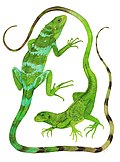Galapagos land iguana
| Galápagos land iguana | |
|---|---|

| |
| Scientific classification | |
| Domain: | Eukaryota |
| Kingdom: | Animalia |
| Phylum: | Chordata |
| Class: | Reptilia |
| Order: | Squamata |
| Suborder: | Iguania |
| Family: | Iguanidae |
| Genus: | Conolophus |
| Species: | C. subcristatus
|
| Binomial name | |
| Conolophus subcristatus (Gray, 1831)
| |
The Galápagos land iguana (Conolophus subcristatus) is a very large species of lizard in the family Iguanidae, and one of three species of the genus Conolophus. It is endemic to the Galápagos Islands off of Ecuador's Pacific coast, inhabiting the dry lowlands of Fernandina, Isabela, Santa Cruz, North Seymour, Baltra, and South Plaza islands.[1][3][4]
Taxonomy[edit]
The land iguanas of Galápagos vary in morphology and coloration among different populations.[5] In addition to the relatively widespread, well-known Galápagos land iguana (C. subcristatus), there are two other species within Conolophus—the Galápagos pink land iguana (C. marthae), of northern Isabela Island, and the Santa Fe land iguana (C. pallidus), of Santa Fe Island.[5][6] Based on mtDNA, the ancestors of today's land iguanas and marine iguanas (Amblyrhynchus cristatus) separated about 8–10 million years ago (MYA).[7][8] Within the land iguana genus, the oldest split (based on mtDNA—about 5.7 MYA) is between C. subcristatus and C. marthae.[8][9] A more-recent study, which included both mtDNA and nuclear DNA, indicated that the marine iguana split from the land iguana about 4.5 MYA; among the land iguanas, C. subcristatus and C. marthae split from each other about 1.5 MYA.[10] The differentiation between C. subcristatus and C. pallidus is less clear; it has been questioned whether they are separate species.[5] Based on mtDNA and cytochrome b, they fall into three monophyletic groups: C. subcristatus of the western islands (Isabela and Fernandina), C. subcristatus of the central islands (Santa Cruz, Baltra and South Plaza), and C. pallidus. Although the exact pattern is uncertain, it is possible that C. pallidus is closer to one of the C. subcristatus groups than the two C. subcristatus groups are to each other.[9]
The specific name subcristatus is derived from the Latin words sub (meaning "lesser"):and cristatus (meaning "crested"), and refers to the low crest of spines along the animal's back, which is not as tall as in other iguanas, like the green iguana (Iguana iguana).
Anatomy and morphology[edit]
Charles Darwin described the Galápagos land iguanas he observed as "ugly animals, of a yellowish orange beneath, and of a brownish-red colour above: from their low facial angle they have a singularly stupid appearance."[11]
The Galápagos land iguana is one of the largest lizards in the world,[12] growing to a length of 0.9 to 1.5 m (3–5 ft), with a body weight of up to 13 kg (29 lb), depending upon which island they are from.[13][14] Being cold-blooded, they raise their body temperature by basking on volcanic rock or other dark-colored stones that naturally absorb the heat of the sun. By night, they sleep in burrows to conserve their absorbed body heat.[13] These iguanas also enjoy a symbiotic relationship with birds; the birds remove parasites, such as ticks, providing relief to the iguanas and food for the birds.[3][15]
Diet and longevity[edit]

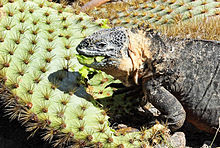
Land iguanas are primarily herbivorous; however, some individuals have shown that they are opportunistic omnivores, supplementing their diet with invertebrates, such as centipedes or arachnids, and carrion.[3] Because fresh water is scarce on the islands, the Galápagos land iguana obtains the bulk of its moisture from the prickly-pear cactus (Opuntia sp.), in addition to other Cactaceae species, which makes up nearly 80% of its diet. All parts of the plant are consumed, including the fruit, flowers, pads, and even the sharp spines.[3][13] During the rainy season, land iguanas will drink from temporary vernal pools and other accumulated sources of water, and feast on the blousy, yellow flowers of the perennial succulent genus Portulaca.[13][15]
The Galápagos land iguana has a 60- to 69-year lifespan.[3][14]
Reproduction[edit]
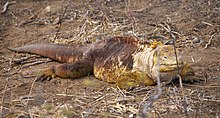
Galápagos land iguanas become sexually mature anywhere between eight and fifteen years of age, depending on which island they are from.[3] Mating season also varies between islands, but soon after mating, the females migrate to sandy areas to nest, laying 2–20 eggs in a burrow about 50 cm (20 in) deep.[3] The eggs hatch anywhere from 90 to 125 days later.[3][14]
On South Plaza Island, where the territories of marine iguanas and land iguanas overlap, the two sometimes interbreed, resulting in a hybrid iguana that shows a mixture of features from each species.[3] The most likely unions tend to be between male marine iguanas and female land iguanas. Despite their long separation time and their being two distinct species from different genera, the offspring are viable, although likely sterile.[3][5]
Population[edit]
It is estimated that between 5,000 and 10,000 land iguanas are found throughout the Galápagos Islands.[3] These iguanas were so abundant on Santiago Island at one time that naturalist Charles Darwin remarked (when it was called King James Island) that "...when we were left at James, we could not for some time find a spot free from their burrows on which to pitch our single tent".[13][16] In the years since, entire populations (including all the animals on Santiago Island) have been wiped out by introduced feral animals, such as pigs, rats, cats, and dogs.[3][13]
Evolutionary history[edit]
Researchers theorize that Galápagos land iguanas and marine iguanas evolved from a common ancestor since arriving on the islands from South America, presumably by rafting.[17][18] The marine iguana diverged from the land iguana some 8 million years ago, which is older than any of the extant Galápagos islands.[19][7] It is therefore thought that the ancestral species inhabited parts of the volcanic archipelago that are now submerged. The two species remain mutually fertile in spite of being assigned to distinct genera, and they occasionally hybridize where their ranges overlap.
Recovery efforts[edit]
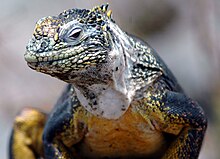
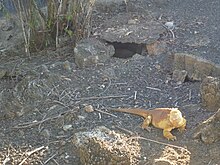

Beginning in the early 1990s, the Galápagos land iguana has been the subject of an active reintroduction campaign on Baltra Island. These animals became extinct on Baltra by 1954, allegedly wiped out by soldiers stationed there who shot the iguanas for amusement.[3][15] However, in the early 1930s, William Randolph Hearst had translocated a population of land iguanas from Baltra to North Seymour Island, a smaller island just a few hundred metres north of Baltra, because he could not understand why no iguanas were present there. Hearst's translocated iguanas survived and became the breeding stock for the Charles Darwin Research Station captive breeding program that has successfully reintroduced the species to Baltra and a number of other areas.[3] Visitors today frequently see iguanas on both the runway of the Baltra airport or while they cross the road.
References[edit]
- ^ a b Kumar, K.; Gentile, G.; Grant, T.D. (2020). "Conolophus subcristatus". IUCN Red List of Threatened Species. 2020: e.T5240A3014082. doi:10.2305/IUCN.UK.2020-2.RLTS.T5240A3014082.en. Retrieved 17 November 2021.
- ^ "Appendices | CITES". cites.org. Retrieved 2022-01-14.
- ^ a b c d e f g h i j k l m n "Land iguanas" (PDF). Charles Darwin Research Station Fact Sheet. Charles Darwin Foundation for the Galapagos Islands. 2006. Archived from the original (PDF) on 2007-06-06. Retrieved 2007-10-14.
- ^ Swash, A.; R. Still (2000). Birds, Mammals & Reptiles of the Galápagos Islands. Yale University Press. pp. 118–119. ISBN 0-300-08864-7.
- ^ a b c d Rassmann, Kornelia; Markmann, Melanie; Trillmich, Fritz; Tautz, Diethard (2004), "Tracing the Evolution of the Galapagos Iguanas", Iguanas: Biology and Conservation, California: University of California Press, pp. 71–83, ISBN 978-0-520-23854-1
- ^ Gentile, Gabriele; Anna Fabiani; Cruz Marquez; Howard L. Snell; Heidi M. Snell; Washington Tapia; Valerio Sbordonia (2009). "An overlooked pink species of land iguana in the Galapagos". Proceedings of the National Academy of Sciences of the United States of America. 106 (2). National Academy of Sciences of the United States of America: 507–11. doi:10.1073/pnas.0806339106. PMC 2626733. PMID 19124773.
- ^ a b "Explaining the Divergence of the Marine Iguana Subspecies on Espa". amnh.org.
- ^ a b Black, Richard (5 January 2009). "Pink iguana rewrites family tree". BBC News. BBC. Retrieved 20 May 2017.
- ^ a b Gabriele Gentile; Anna Fabiani; Cruz Marquez; Howard L Snell; Heidi M Snell; Washington Tapia; Valerio Sbordoni (2009). "An overlooked pink species of land iguana in the Galápagos". Proceedings of the National Academy of Sciences of the United States of America. 106 (2). National Academy of Sciences of the United States of America: 507–511. doi:10.1073/pnas.0806339106. PMC 2626733. PMID 19124773.
- ^ MacLeod, A.; A. Rodríguez; M. Vences; P. Orozco-terWengel; C. García; F. Trillmich; G. Gentile; A. Caccone; G. Quezada; S. Steinfartz (2015). "Hybridization masks speciation in the evolutionary history of the Galápagos marine iguana". Proceedings of the Royal Society B. 282 (1809): 20150425. doi:10.1098/rspb.2015.0425. PMC 4590447. PMID 26041359.
- ^ Darwin, Charles (1989), The Voyage of the Beagle: Charles Darwin's Journal of Researches, New York: Penguin Classics, p. 401, ISBN 978-0-14-043268-8
- ^ "The 10 Largest Lizards in The World". a-z-animals.com. 18 August 2021. Retrieved 12 February 2022.
- ^ a b c d e f Rogers, Barbara (1990), Galapagos, New York: Mallard Press, p. 144, ISBN 978-0-7924-5192-1
- ^ a b c Rosenthal, Ellen (1997), "Days and nights of the iguana: in the Galapagos, a devoted pair work to save land iguanas", Animals
- ^ a b c Kricher, John (2006), Galapagos: A Natural History, New Jersey: Princeton University Press, pp. 9, 51, 91, 200, ISBN 978-0-691-12633-3
- ^ Darwin, Charles (1839), Narrative of the surveying voyages of His Majesty's Ships Adventure and Beagle between the years 1826 and 1836, describing their examination of the southern shores of South America, and the Beagle's circumnavigation of the globe. Journal and remarks., London: Henry Colburn, p. 488
- ^ Rassmann, K.; Tautz, D.; Trillmich, F.; Gliddon, C. (1997). "The micro – evolution of the Galápagos marine iguana Amblyrhynchus cristatus assessed by nuclear and mitochondrial genetic analysis". Molecular Ecology. 6 (5): 437. doi:10.1046/j.1365-294X.1997.00209.x. S2CID 84822976.
- ^ Marine Iguana. marinebio.org.
- ^ Rassmann, Kornelia (1997). "Evolutionary age of the Galápagos iguanas predates the age of the present Galápagos Islands". Molecular Phylogenetics and Evolution. 7 (2): 158–172. doi:10.1006/mpev.1996.0386. PMID 9126557. Retrieved 18 January 2023.
External links[edit]
- Galápagos Conservation Trust Archived 2007-10-10 at the Wayback Machine
- galapagosonline.com
- PBS:Destination Galápagos Islands Archived 2015-05-08 at the Wayback Machine
- Conolophus subcristatus at Animal Diversity Web
- Galápagos Land Iguana feeding on a cactus – video clip


